Words Miguel Llona
Images PIID and WAF/INSIDE




Since 2014, Filipino architecture firms have been making waves at the prestigious World Architecture Festival, taking home the top prize for some categories or getting high commendations from the jury. Each year has seen more firms shortlisted than the previous year, with 2021 proving to be the most successful yet with 9 projects from 6 firms shortlisted in over 11 categories. It’s a reflection of Filipino architecture gaining more recognition internationally and has encouraged more and more architects to join each year.
But what about interior designers? In contrast to the Philippines’ strong presence at the WAF, the country has barely made a dent in INSIDE, the WAF’s counterpart for interior design. There have only been two Filipino projects shortlisted for INSIDE, and both were done by an architect (Jorge Yulo, for Mecha Uma and La Cabana de Resureccion). It is a global opportunity that has yet to be maximized by the local interior design industry, despite the abundance of talented designers in the country. To address this, Kanto partnered with the Philippine Institute of Interior Designers (PIID) to host online watch parties of the winning entries from last year’s INSIDE, in the hopes of preparing and inspiring interior designers to join the competition. With Kanto having exclusive access to the boards and crits from last year’s competition, professionals and students alike had the opportunity to see how designers defend their work in front of a three-man jury, or simply be exposed to innovative designs from around the world. Guiding the audience throughout the watch parties are pairs of architects and interior designers for each day, with the former being a past WAF finalist to provide a firsthand perspective of the competition.


Day 4: Retail and Temporary Uses
IDr. Chat Fores and Ar. Sudarshan Khadka couldn’t have been a more unusual pairing of mentors, but their differences introduced various nuances and perspectives throughout the whole watch party. Fores’ flamboyant and colorful language complemented Khadka’s even-keeled responses, leading to discussions that provided plenty of insight for the audience. The categories up for discussion, Retail and Temporary Uses, reflected the mentors’ differing personalities as well, as they necessitated different approaches to interior design. With the discussion facilitated by IDr. Heidrun Milan, principal of Heidrun Milan Design Studio, and Kanto EIC Patrick Kasingsing, the watch party weathered some technical difficulties to deliver nuggets of wisdom to the PIID audience.


Retail
Jolor Flagship Store by Atelier Tao + C
Winner – Retail Category
In a surprising turn of events, two winners were chosen for the Retail category for INSIDE 2021. Atelier Tao+C (whose Capsule Hostel won World Interior of the Year in the same competition) was one of the two winners recognized for the category award, with its design of the Jolor flagship showroom, a minery warehouse in Shanghai transformed into a furniture store that heavily uses black terrazzo as a material.
The boards that Atelier Tao+C made for the Jolor showroom mirror the simplicity of the project’s interior design. Khadka called the boards simple and essential, yet manage to be striking at first sight and speak for themselves despite their minimal look. “[Judges] are looking to be captured, captivated by that initial image at the start, but of course, it gets deeper once you get more into the project,” says Khadka.
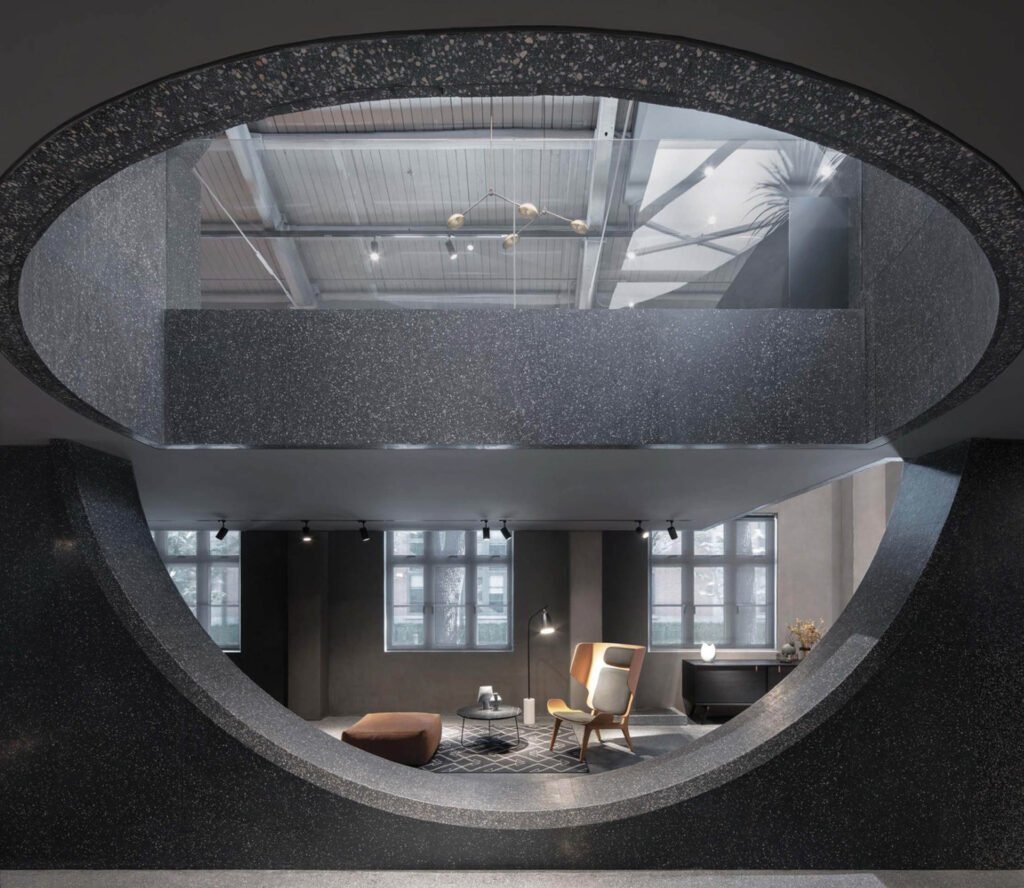

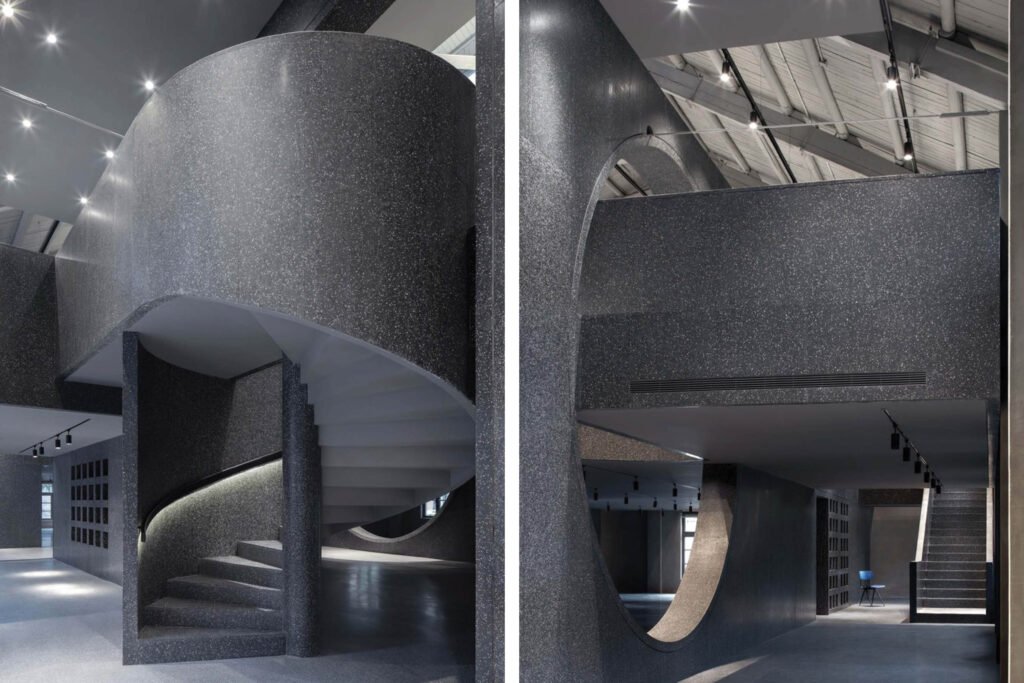

This observation by Khadka flows into his main point for Atelier Tao+C’s crit, in which the architects were able to clearly present a narrative of how they were able to transform and complete the project. What he enjoyed about the presentation is the way the jurors probed Atelier Tao+C about the “memory embedded in the materiality” of the project, which shows just how skilled and insightful the jurors are. “They were able to read the mind of the design while watching the presentation. So that is something you need to be considerate of, the skill level of the jurors,” he says. Fores compounds Khadka’s point by saying that one actually understands the project more while listening to the judges due to the thoroughness of their questions, even down to the nitty-gritties.
Atelier Tao+C’s firmness in defending their design choices is something that drew Fores’ admiration. During the crit, the jury had been questioning the use of black terrazzo for the interiors, a color frowned upon by the Chinese, but Atelier Tao+C kept reiterating the significance of the material in preserving the memory of the place. “I liked that she stood her ground,” says Fores, insinuating that Filipino designers should learn to defend their ideas more.
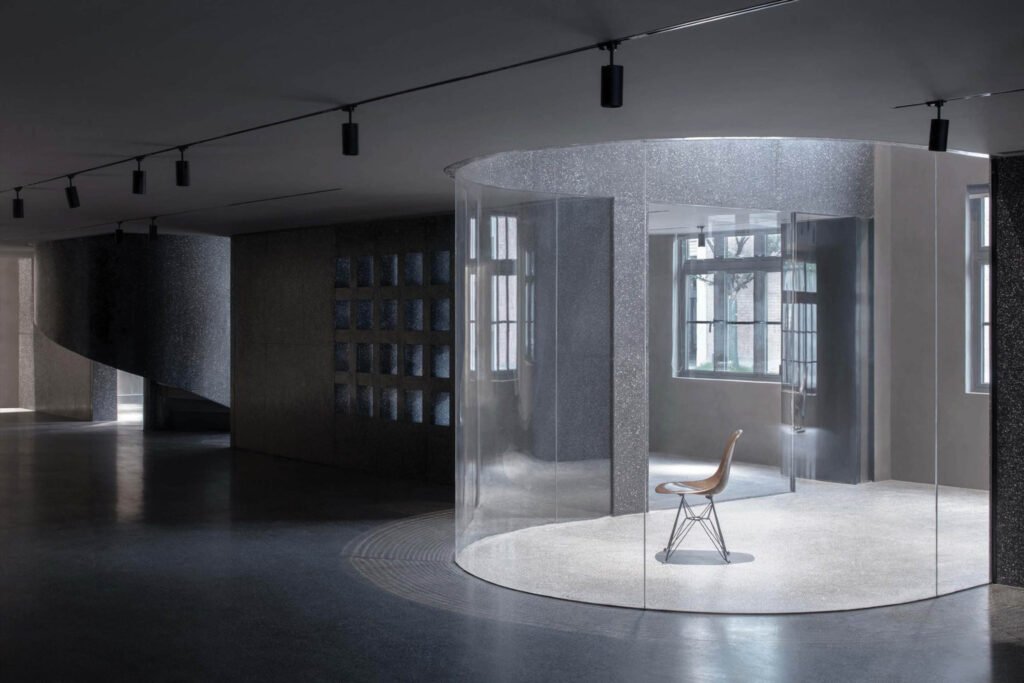



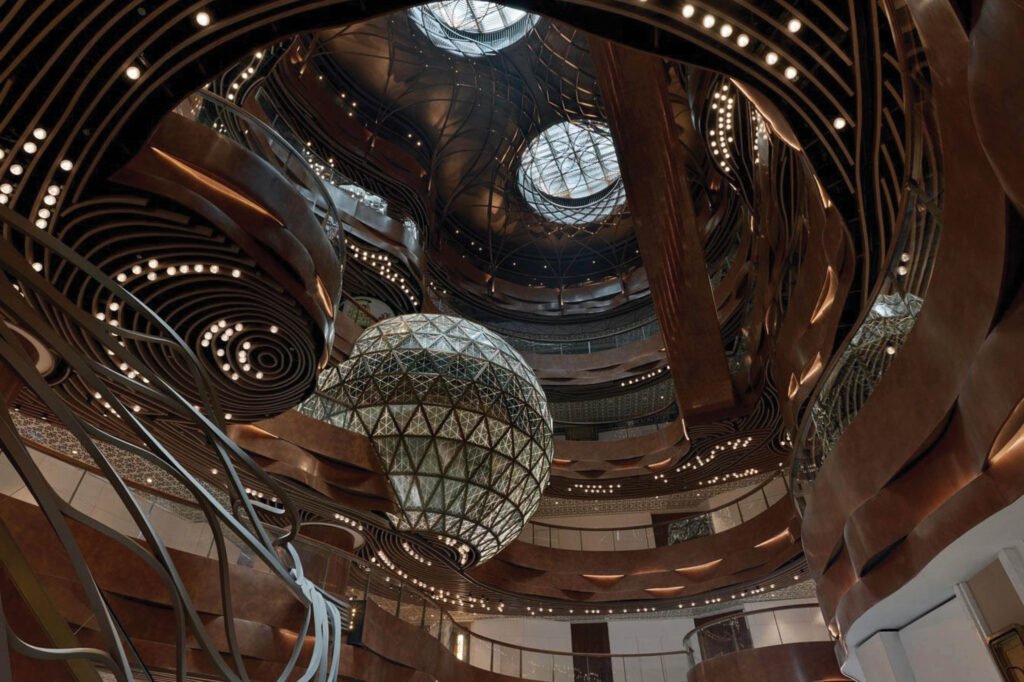
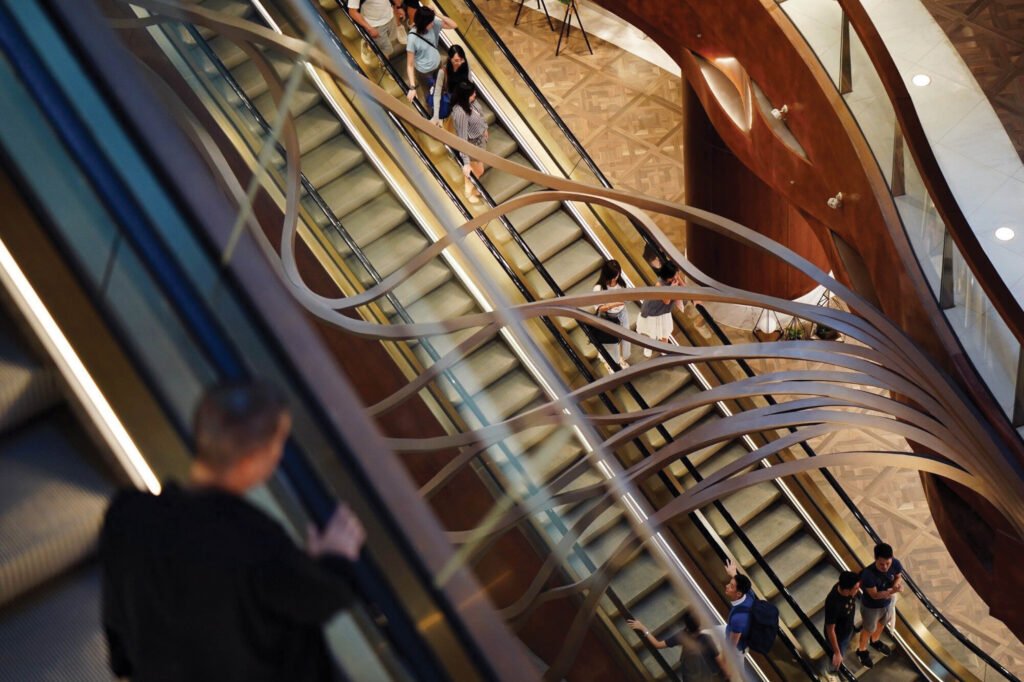
K11 Musea by AB Concept, KPF, LAAB & Speirs and Major
Winner – Retail Category
The other winner of the category is a unique typology: a cultural mall located in Hongkong, which Khadka and Fores surmised was a huge reason for its win. The discussion mostly centered on why the jury felt the need to recognize two winners instead of awarding a Highly Commended citation. What were the positives and advantages displayed by the Jolor showroom and K11 Musea that elevated them both in the jury’s eyes, despite being opposing designs? What values were the jurors espousing that played into their choice of winners for the category?
Khadka sees both projects as being on opposite ends of the spectrum, in terms of their approach to creating retail space. Whereas the design of the Jolor showroom was abstract, K11 Musea was designed for exuberance and extravagance as it positions itself to be a space for art, music, and culture within a commercial typology. The fact that the jury recognized the merits of both approaches, despite being vastly different, is something to be commended. “WAF does recognize that there is a plurality in approaches, and they do recognize excellence in both ways,” says Khadka. “So I think that leaves us very open to submitting whatever we want, as long as the quality is that it is the most excellent version of what it could be.”


Fores echoes Khadka’s observations, paying particular attention to the quirkiness of K11 Musea and the multiple narratives the design team tried to weave into the design. The way the designers were able to create an overarching narrative in spite of all its interweaving ones is what led the jury to reward this alongside the subtler Jolor showroom.
The discussion then turned to what Filipino designers should focus on should they compete in this category. Khadka and Fores share the same advice: highlight our own heritage. “Highlight your best assets, highlight your culture,” says Fores. “You know, culturally, we lose to Thailand, because they really embrace their culture. And that’s what we have to do, instead of getting bits and pieces from here and there.” For Khadka, he uses creative restaurants that only use local materials for their cuisine as an example of how to create something truly unique. “They’re being authentic to the context by trying to look at what is available locally and being creative about how they process it and create a compelling concept that relates to compelling expression. I think that can be similarly done with architecture and interior design,” he says.


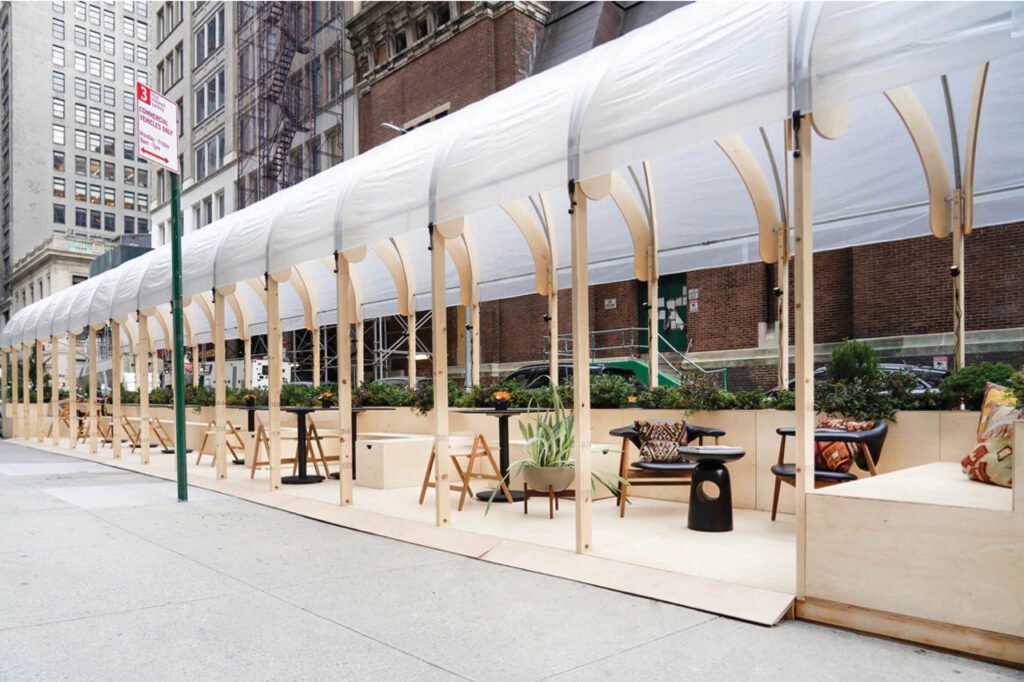



Temporary Uses
Re-Ply by BVN
Winner – Temporary Uses category
BVN’s entry for the Temporary Uses category was one that captivated the jury with its story alone. In the wake of the Black Lives Matters protests, several businesses shuttered their storefronts with plywood to protect against damage, and BVN saw the opportunity to reuse these plywood boards as frameworks and barriers for al fresco dining around New York City, to help these businesses during the COVID-19 pandemic. The concept of helping the very businesses affected by the protests, with the same materials they used to barricade their stores, propelled the Re-Ply project to a win.
The boards for this project differ from most of the entries for INSIDE, with its grid layout that shows the different applications done by the design firm. While Khadka thinks the boards were able to capture what the firm was trying to do, he believes the context was lost amid the wall of text, and it would’ve worked better if they laid it out in a simpler manner. Fores is taken in by the project’s ingenuity and impressed by its easy assembly and multiple applications. “When you do something temporary, it should always surprise,” she says.




Milan brought up the potential of Filipino designers to excel in this category, considering that the country suffers from natural calamities often. In response to Milan’s question on what juries are potentially looking for in this category, Fores says that Re-Ply’s ease of assembly, economy of scale, cheap cost, and sustainability are what made it win. Its response to the time and context, in this case the Black Lives Matter movement, also played a huge role in its win, according to Khadka. He said the jury appreciated “how [BVN] was able to pick up this issue, and also how they were able to respond to it in a creative way that also addressed the other contexts [like the COVID-19 pandemic].”
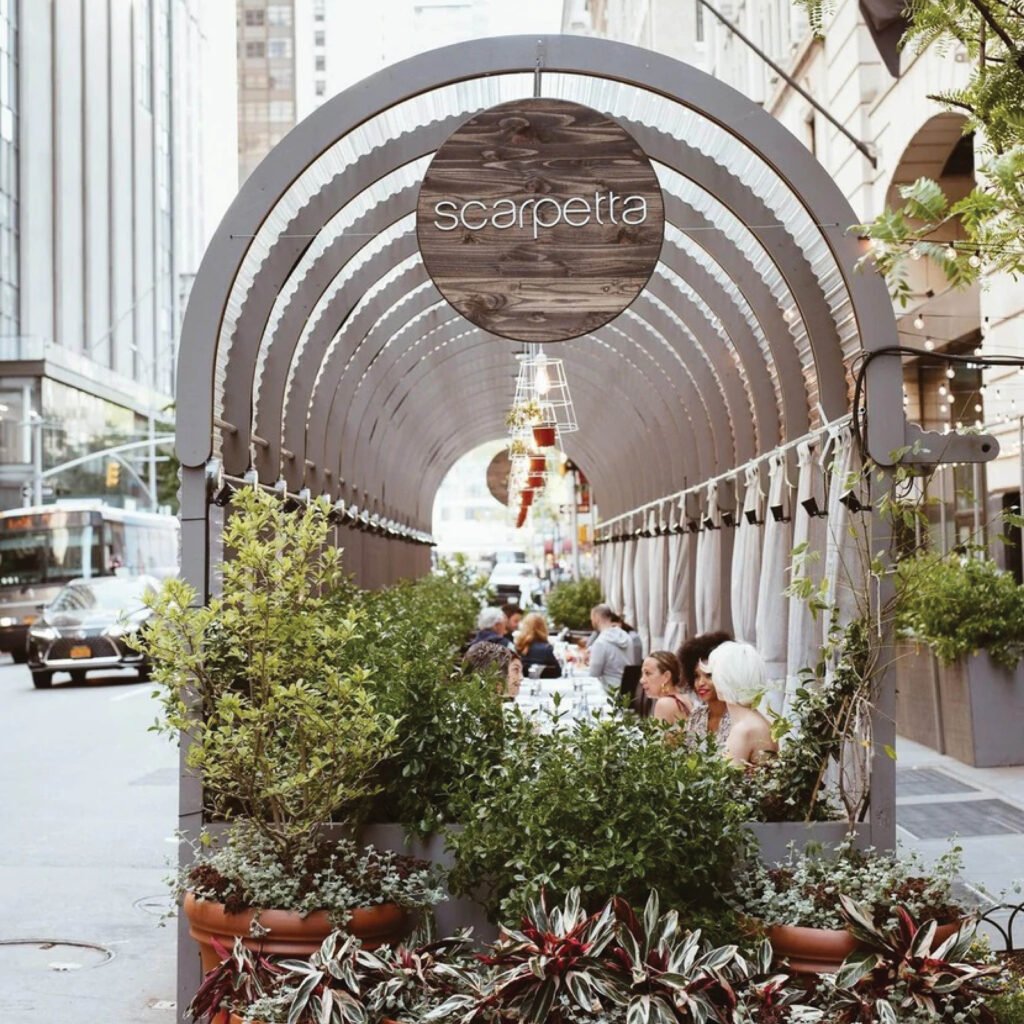

But while everyone is all praises for the project, a question was asked: is Re-Ply even an interior design project? There is a valid argument to be made that this could be considered industrial design, but the mentors push back against this argument. “It does create an interior environment in many of the spaces that it does propose, so just the fact that it’s not overt doesn’t make it any less of an interior,” says Khadka. Fores concurs by saying the firm simply designed interior spaces and brought them to the outside, hence its inclusion in the interior category.


Furniture Pavilion S by Rooi Design
Highly Commended – Temporary Uses category
Rooi Design’s Furniture Pavilion S, an outdoor pavilion designed for a furniture exhibitor during the Shanghai International Furniture Fair 2019, is an entry that Khadka believes should have won the category. He cites the execution of its design and overall aesthetic as the reasons why it should have won. “It is a beautiful project, well-thought-out. It’s well-executed in terms of how it creates that connection between the function of being a furniture display, as well as creating a piece of architecture that’s striking,” he says.
In the end, he admits that the social relevance and timeliness of Re-Ply are what ultimately edged it ahead of the Furniture Pavilion S, which at its core is simply a commercial exhibition. Having more applications towards the community elevates Re-Ply as well, compared to the limited uses for the pavilion’s wood after the exhibit. The marketing behind Re-Ply was stronger as well, according to Fores. “I think the judges were dead set on Re-Ply, even during the interview, maybe a little biased,” she says. “Some of the furniture designs repurposed from the pavilion actually look more comfortable than those in Re-Ply, but as I said, the judges seemed dead set on their decision.”
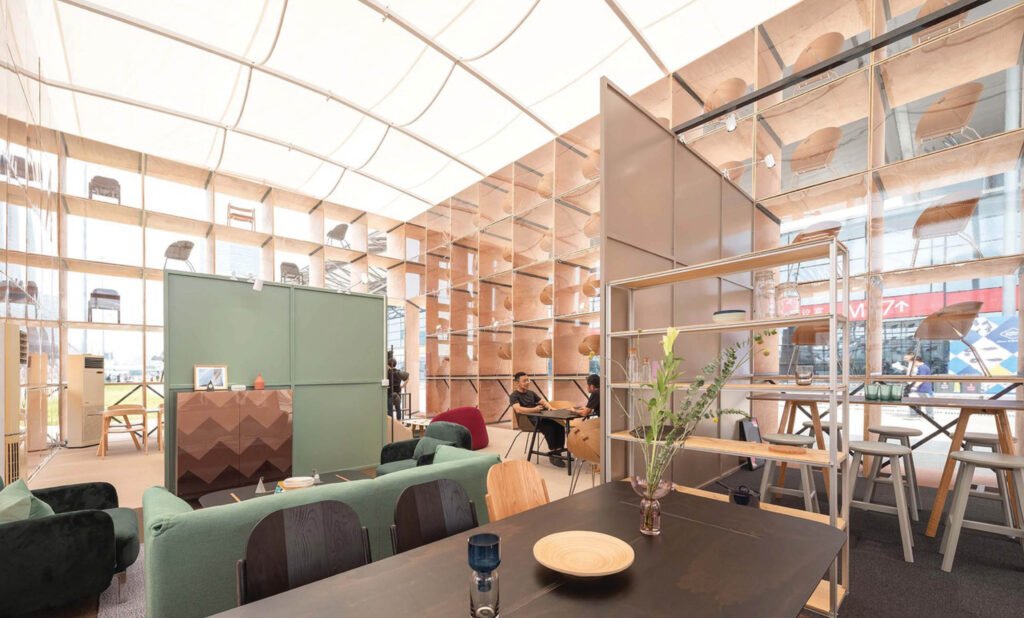



Fores brought up the bias she felt the jury had against the pavilion project, as their questions seemed condescending compared to how they were with Re-Ply. Khadka, having faced intense scrutiny from juries in the past, explained that juries sometimes try to catch the designer off-guard with basic questions when they have nothing more critical to add. “I think [the designer] should use that opportunity to redirect the question towards something that helps them explain a bit more about your narrative. Re-Ply was able to do that in response to some of the questions, while the other team did not,” says Khadka.
A piece of practical advice offered by Fores in relation to Furniture Pavilion S is the use of the most flattering pictures for one’s presentation, which she felt the designers didn’t do. “If they had better pictures, better angles…and they also shouldn’t have included shots where it was raining. They opened themselves up for questions because of that,” she says, referring to how the INSIDE jury had asked the designers about the pavilion’s durability during rough weather. Even Milan expressed skepticism over the pavilion’s roof design, with its lack of eaves and downspouts that would be problematic in the event of rain.

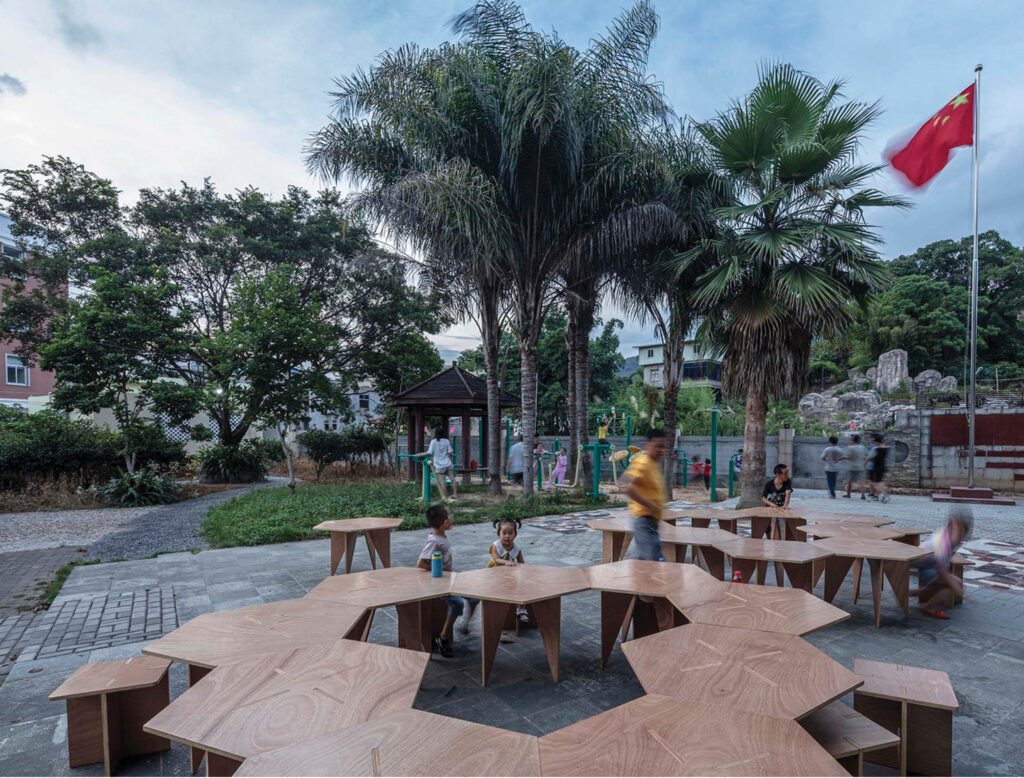
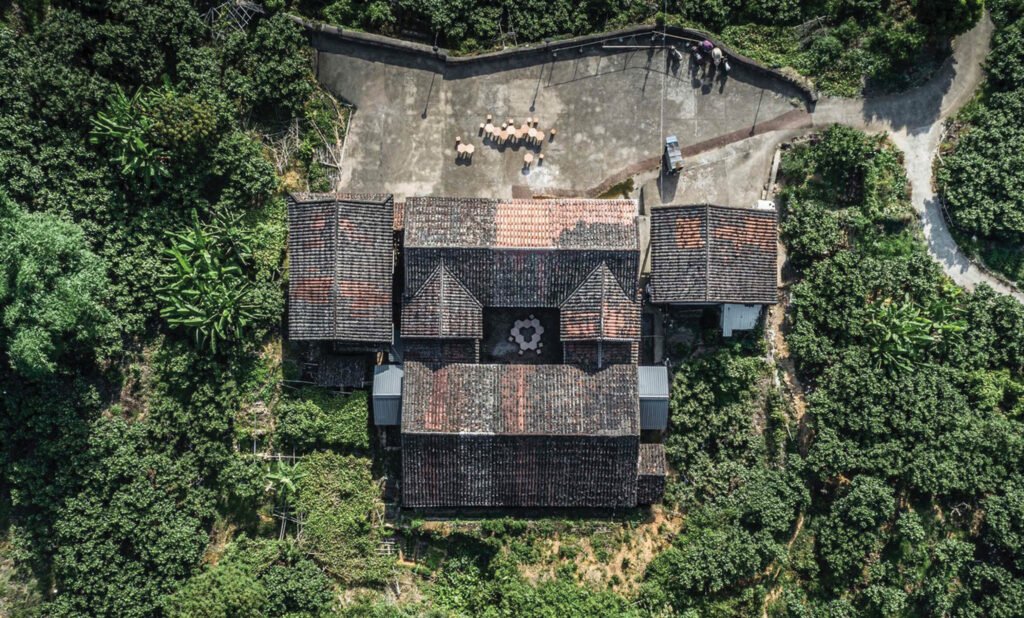
As a parting note, Fores reiterates that presenting your project through the best photos “is a lesson we should learn when we join contests. You have to strike your Instagram brains on, diba? Instagram versus reality, you have to put your game face on.”
Final Takeaways
Fores’s main advice for designers thinking of joining any competition is that their design should be instinctive—something you love and believe in, something you really feel strongly about. Defending a project you feel strongly about will then come easy. In relation to defending one’s work though, Fores commented on how underdressed some of the designers were for their presentations, which is a huge no-no. “There’s nothing better than judging people who look good. It’s nice to talk to people that look like they dressed up for the contest,” she says. It might seem shallow, but it’s still advice that needs to be heeded!
The wide range of applications and designs in the day’s crits affirms for Khadka the beauty of competitions like WAF and INSIDE. “[There is] room for everyone to participate in different aspects of the competition,” he says. “You’ll never know how you place or how you relate to the world if you don’t participate. So I think it’s important that everyone at least conceives of ourselves in relation to the world context…because that’s the way that we are able to make contributions to the discourse of architecture and interior design globally.” Filipino designers have to fight to express their identity, even in the smallest of details, in order to develop their language and move forward in the global scene.
Having the confidence to expand one’s horizons—that’s the first step toward competing in international competitions like INSIDE. The hope that Fores and Khadka have is for our local interior designers to cultivate belief in themselves, and to champion in their designs the heritage that we so often dismiss. •

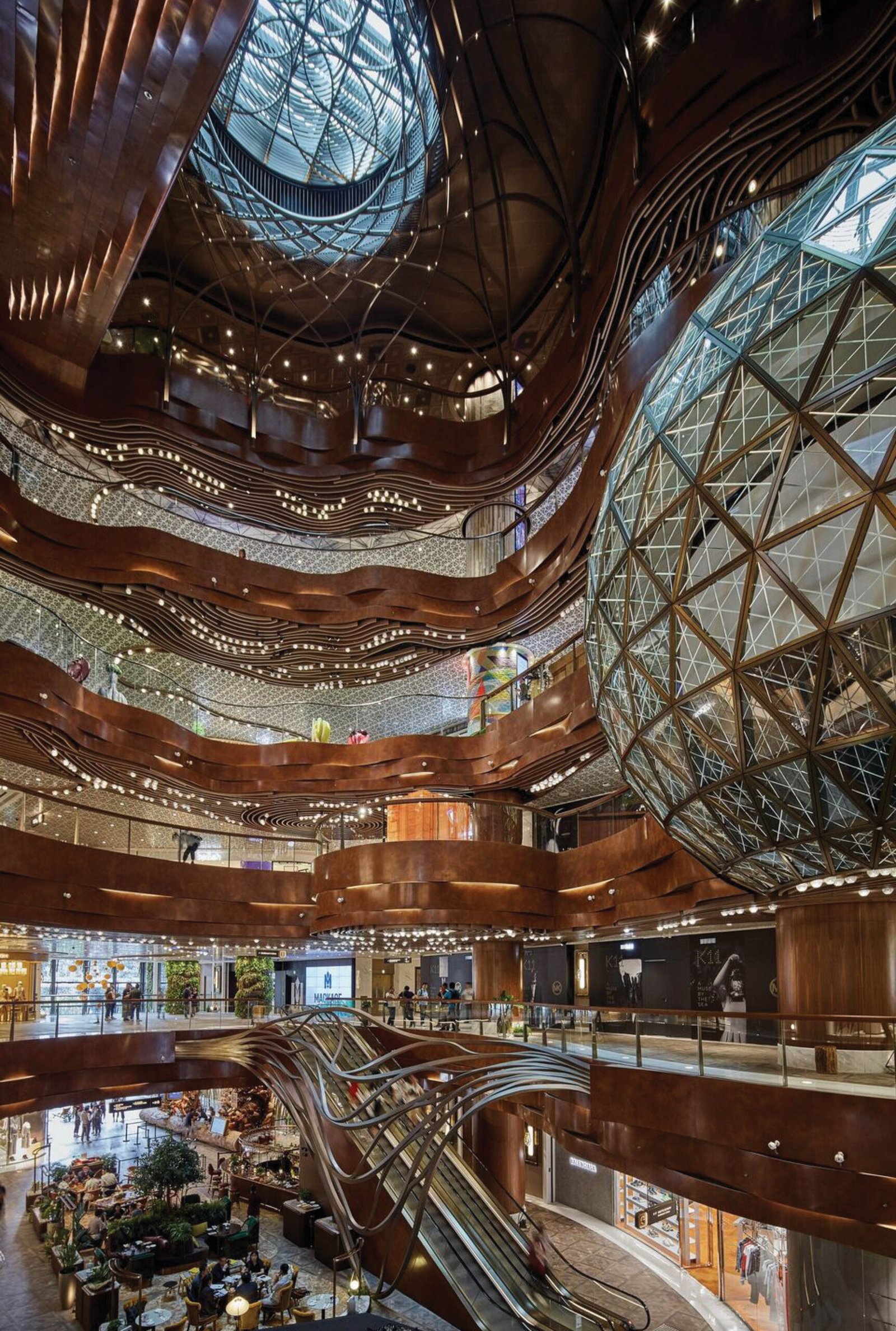
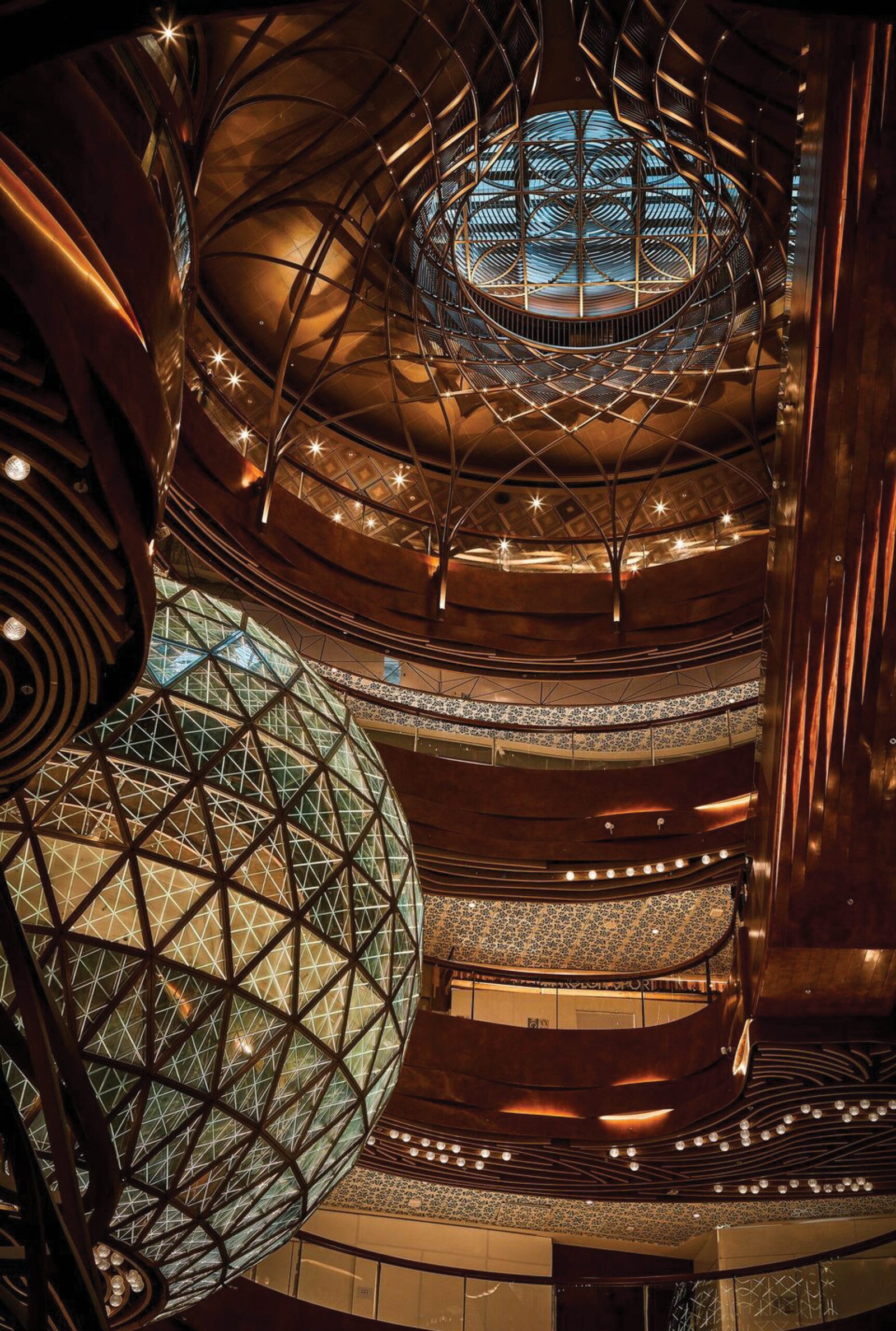

3 Responses